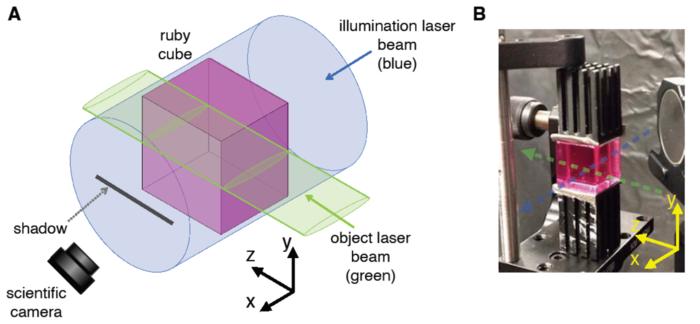Particles of light – photons – are massless, so they normally pass right through each other. This generally means they can’t cast a shadow. In a new work, however, physicist Jeff Lundeen of the University of Ottawa, Canada and colleagues found that this counterintuitive behaviour can, in fact, happen when a laser beam is illuminated by another light source as it passes through a highly nonlinear medium. As well as being important for basic science, the work could have applications in laser fabrication and imaging.
The light-shadow experiment began when physicists led by Raphael Akel Abrahao sent a high-power beam of green laser light through a cube-shaped ruby crystal. They then illuminated this beam from the side with blue light and observed that the beam cast a shadow on a piece of white paper. This shadow extended through an entire face of the crystal. Writing in Optica, they note that “under ordinary circumstances, photons do not interact with each other, much less block each other as needed for a shadow.” What was going on?
Photon-photon interactions
The answer, they explain, boils down to some unusual photon-photon interactions that take place in media that absorb light in a highly nonlinear way. While several materials fit this basic description, most become saturated at high laser intensities. This means they become more transparent in the presence of a strong laser field, producing an “anti-shadow” that is even brighter than the background – the opposite of what the team was looking for.
What they needed, instead, was a material that absorbs more light at higher optical intensities. Such behaviour is known as “reverse saturation of absorption” or “saturable transmission”, and it only occurs if four conditions are met. Firstly, the light-absorbing system needs to have two electronic energy levels: a ground state and an excited state. Secondly, the transition from the ground to the excited state must be less strong (technically, it must have a smaller cross-section) than the transition from the first exited state to a higher excited state. Thirdly, after the material absorbs light, neither the first nor the second excited states should decay back to other levels when the light is re-emitted. Finally, the incident light should only saturate the first transition.

That might sound like a tall order, but it turns out that ruby fits the bill. Ruby is an aluminium oxide crystal that contains impurities of chromium atoms. These impurities distort its crystal lattice and give it its familiar red colour. When green laser light (532 nm) is applied to ruby, it drives an electronic transition from the ground state (denoted 4A2) to an excited state 4T2. This excited state then decays rapidly via phonons (vibrations of the crystal lattice) to the 2E state.
At this point, the electrons absorb blue light (450 nm) and transition from 2E to a different excited state, denoted 2T1. While electrons in the 4A2 state could, in principle, absorb blue light directly, without any intermediate step, the absorption cross-section of the transition from 2E to 2T1 is larger, Abrahao explains.
The result is that in the presence of the green laser beam, the ruby absorbs more of the illuminating blue light. This leaves behind a lower-optical-intensity region of blue illumination within the ruby – in other words, the green laser beam’s shadow.
Shadow behaves like an ordinary shadow
This laser shadow behaves like an ordinary shadow in many respects. It follows the shape of the object (the green laser beam) and conforms to the contours of the surfaces it falls on. The team also developed a theoretical model that predicts that the darkness of the shadow will increase as a function of the power of the green laser beam. In their experiment, the maximum contrast was 22% – a figure that Abrahao says is similar to a typical shadow on a sunny day. He adds that it could be increased in the future.
Lundeen offers another way of looking at the team’s experiment. “Fundamentally, a light wave is actually composed of a hybrid particle made up of light and matter, called a polariton,” he explains. “When light travels in a glass or crystal, both aspects of the polariton are important and, for example, explain why the wave travels more slowly in these media than in vacuum. In the absence of either part of the polariton, either the photon or atom, there would be no shadow.”
Strictly speaking, it is therefore not massless light that is creating the shadow, but the material component of the polariton, which has mass, adds Abrahao, who is now a postdoctoral researcher at Brookhaven National Laboratory in the US.
As well as helping us to better understand light-matter interactions, Abrahao tells Physics World that the experiment “could also come in useful in any device in which we need to control the transmission of a laser beam with anther laser beam”. The team now plans to search for other materials and combinations of wavelengths that might produce a similar “laser shadow” effect.
The post Laser beam casts a shadow in a ruby crystal appeared first on Physics World.

